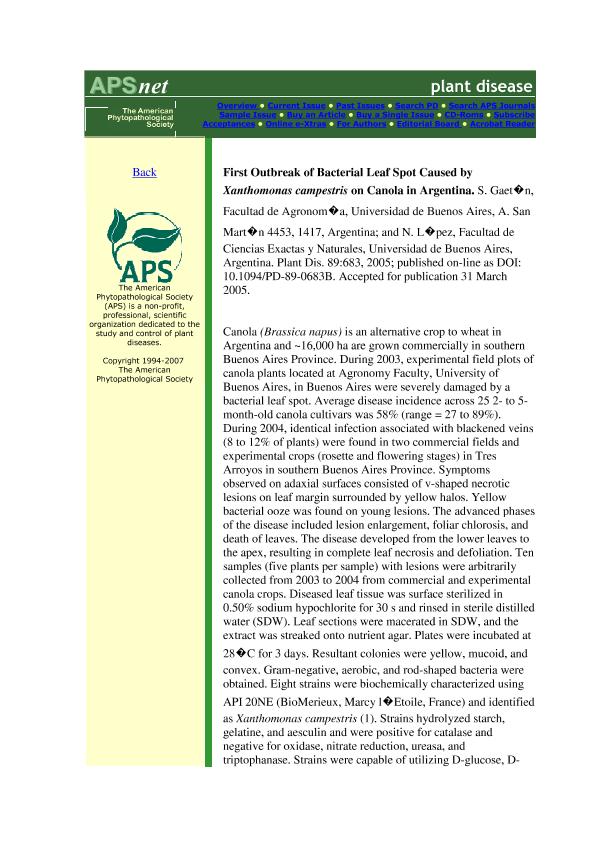Mostrar el registro sencillo del ítem
dc.contributor.author
Gaetán, Sara

dc.contributor.author
López, Nancy Irene

dc.date.available
2020-04-20T17:50:11Z
dc.date.issued
2005-06
dc.identifier.citation
Gaetán, Sara; López, Nancy Irene; First Outbreak of Bacterial Leaf Spot Caused by Xanthomonas campestris on Canola in Argentina; American Phytopathological Society; Plant Disease; 89; 6; 6-2005; 683-683
dc.identifier.issn
0191-2917
dc.identifier.uri
http://hdl.handle.net/11336/103066
dc.description.abstract
Canola (Brassica napus) is an alternative crop to wheat in Argentina and ~16,000 ha are grown commercially in southern Buenos Aires Province. During 2003, experimental field plots of canola plants located at Agronomy Faculty, University of Buenos Aires, in Buenos Aires were severely damaged by a bacterial leaf spot. Average disease incidence across 25 2- to 5-month-old canola cultivars was 58% (range = 27 to 89%). During 2004, identical infection associated with blackened veins (8 to 12% of plants) were found in two commercial fields and experimental crops (rosette and flowering stages) in Tres Arroyos in southern Buenos Aires Province. Symptoms observed on adaxial surfaces consisted of v-shaped necrotic lesions on leaf margin surrounded by yellow halos. Yellow bacterial ooze was found on young lesions. The advanced phases of the disease included lesion enlargement, foliar chlorosis, and death of leaves. The disease developed from the lower leaves to the apex, resulting in complete leaf necrosis and defoliation. Ten samples (five plants per sample) with lesions were arbitrarily collected from 2003 to 2004 from commercial and experimental canola crops. Diseased leaf tissue was surface sterilized in 0.50% sodium hypochlorite for 30 s and rinsed in sterile distilled water (SDW). Leaf sections were macerated in SDW, and the extract was streaked onto nutrient agar. Plates were incubated at 28°C for 3 days. Resultant colonies were yellow, mucoid, and convex. Gram-negative, aerobic, and rod-shaped bacteria were obtained. Eight strains were biochemically characterized using API 20NE (BioMerieux, Marcy l'Etoile, France) and identified as Xanthomonas campestris (1). Strains hydrolyzed starch, gelatine, and aesculin and were positive for catalase and negative for oxidase, nitrate reduction, ureasa, and triptophanase. Strains were capable of utilizing D-glucose, D-mannose, D-maltose, malic acid, and N-acetyl-glucosamine. X. campestris. pv. campestris 8004 was used as a reference strain (2). Pathogenicity and host range for three isolates were completed by injecting a bacterial suspension (107 CFU/ml) into leaves of 2-week-old canola plants (cvs. Eclipse, Impulse, Master, and Mistral), cabbage (B. oleracea var. capitata), and cauliflower (B. oleracea var. botrytis) seedlings (two-leaf stage). The experiment (four inoculated and two control plants for each cultivar and each strain) was conducted in a greenhouse at 24°C and 75% relative humidity. Inoculated and control plants were enclosed in a plastic bag for 48 h after inoculation. Chlorotic patches on the leaves followed by a dry, brown necrosis spread beyond the initial injected area were observed in inoculated plants 8 days after inoculation. Enlarged spots caused death of leaves. The pathogen was successfully reisolated. Control plants, inoculated only with SDW, remained symptomless. The results suggest that the bacterium represents a potential threat to canola production in Argentina and indicate the need for further study to identify the pathovar involved in canola leaf spots. To our knowledge, this is the first report of an outbreak of X. campestris causing leaf spot of canola and in which the bacteria affecting canola commercial crops was biochemically characterized and host range was carried out in Argentina.
dc.format
application/pdf
dc.language.iso
eng
dc.publisher
American Phytopathological Society

dc.rights
info:eu-repo/semantics/openAccess
dc.rights.uri
https://creativecommons.org/licenses/by-nc-sa/2.5/ar/
dc.subject
canola
dc.subject
Bacterial Leaf Spot
dc.subject
Xanthomonas campestris
dc.subject.classification
Otras Ciencias Biológicas

dc.subject.classification
Ciencias Biológicas

dc.subject.classification
CIENCIAS NATURALES Y EXACTAS

dc.title
First Outbreak of Bacterial Leaf Spot Caused by Xanthomonas campestris on Canola in Argentina
dc.type
info:eu-repo/semantics/article
dc.type
info:ar-repo/semantics/artículo
dc.type
info:eu-repo/semantics/publishedVersion
dc.date.updated
2020-02-13T20:11:20Z
dc.journal.volume
89
dc.journal.number
6
dc.journal.pagination
683-683
dc.journal.pais
Estados Unidos

dc.description.fil
Fil: Gaetán, Sara. Universidad de Buenos Aires. Facultad de Agronomía; Argentina
dc.description.fil
Fil: López, Nancy Irene. Consejo Nacional de Investigaciones Científicas y Técnicas. Oficina de Coordinación Administrativa Ciudad Universitaria. Instituto de Química Biológica de la Facultad de Ciencias Exactas y Naturales. Universidad de Buenos Aires. Facultad de Ciencias Exactas y Naturales. Instituto de Química Biológica de la Facultad de Ciencias Exactas y Naturales; Argentina
dc.journal.title
Plant Disease

dc.relation.alternativeid
info:eu-repo/semantics/altIdentifier/url/https://pubmed.ncbi.nlm.nih.gov/30795401/
dc.relation.alternativeid
info:eu-repo/semantics/altIdentifier/doi/http://dx.doi.org/10.1094/PD-89-0683B
dc.relation.alternativeid
info:eu-repo/semantics/altIdentifier/url/https://apsjournals.apsnet.org/doi/10.1094/PD-89-0683B
Archivos asociados
